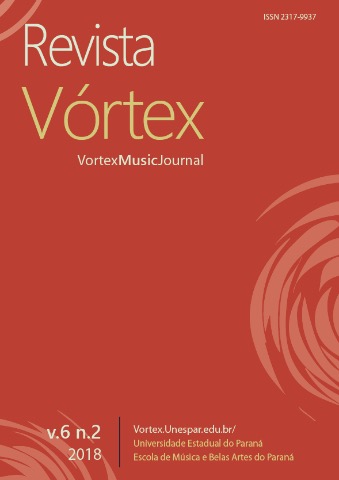Apontamentos históricos e desdobramentos perceptuais sobre o gênero visual music
DOI:
https://doi.org/10.33871/23179937.2018.6.2.2608Resumo
Sobretudo a partir da década de oitenta, alguns artistas visuais que desejavam imitar as qualidades não-representacionais da música absoluta acabaram por engendrar um novo gênero artístico que veio a ser denominado como visual music. Neste artigo, são apresentados apontamentos históricos gerais que antecederam o estabelecimento da visual music como gênero visual nos Estados Unidos e Europa e também algumas obras de autores brasileiros que, embora não as classificassem como visual music, conceberam-nas em acordo com os princípios daquela estética. Por fim, são considerados os aspectos diferenciais das novas possibilidades perceptuais trazidas com a visual music em relação às convenções cinematográficas estabelecidas.Downloads
Referências
COHEN, A. Film music perspectives from cognitive psychology. In: Music and Cinema. Eds. James Buhler, Caryl Flinn, and David Neumeyer. Hanover NH: University Press of New England, 2000.
CORRÊA, Antenor Ferreira. Visual Music: a new perceptual synthesis. In: Sonus Design, Volume 37, No. 1 Fall, 2016, pp.1-10.
DYER, Richard. Side by Side: Nino Rota, Music, and Film. In: Goldmark, D., Kramer, L., Leppert, R. Beyond the Soundtrack: Representing Music in Cinema. Berkeley (CA): University of California Press, 2007.
EVANS, Brian. Foundations of a Visual Music. In: Computer Music Journal, Vol. 29, No. 4, Visual Music (Winter, 2005), pp. 11-24. The MIT Press. Available at: www.jstor.org/stable/3681478
SOUZA, F. Falci de; MAIA, Adolfo. Obtaining Visual Music Dynamic Textures from Grains of Sound and Light. In: Understanding Visual Music, 2013, Buenos Aires. Proceedings of Understanding Visual Music 2013, 2013.
JONES, Randy; NEVILE, Ben. Creating Visual Music in Jitter: Approaches and Techniques. Computer Music Journal. Vol. 29, No. 4, 2005, pp. 55-70. MIT Press available at: www.jstor.org/stable/3681482
KRAMER, Lawrence. Musical Meaning: Toward a Critical History. Berkeley: University of California Press, 2001. http://ark.cdlib.org/ark:/13030/kt838nc7wj/
KALINAK, Kathryn. Settling the Score: Music and the Classical Hollywood Film. Wisconsin: University of Wisconsin Press, 1992.
LEITE, Vânia Dantas. Video Music: a new musical genre. Proceedings of EMS Conference. Buenos Aires, 2009. Disponível em: http://www.ems-network.org/ems09/papers/dantas.pdf acessado dia 22 de junho de 2018.
MORITZ, William. Towards an Aesthetics of Visual Music. 1986. Available at: http://www.centerforvisualmusic.org/TAVM.htm . Accessed: 27/03/2014
MORITZ, William. The Dream of Color Music, and Machines that Made it Possible. Available in:
http://www.awn.com/mag/issue2.1/articles/moritz2.1.html
NORTH, A. C., & HARGREAVES, D. J. The effects of music on responses to a dining area. Journal of Environmental Psychology, 18, 1996, 55-64.
PENN, William. Music and Image: a pedagogical approach. In: Indiana Theory Review, Vol. 11. Indiana: Indiana University, 1991, pp. 47-63.
SMITH, Silvia & SMITH, Stuart. Visual Music. In: Perspectives of New Music, Vol. 20, No. 1/2 (1981/1982), pp. 75-93. Available at: www.jstor.org/stable/942402
Accessed: 21/01/2014.
SMITH, Jeff. Movie music as moving music: Emotion, cognition, and the film score. In: C. Plantinga & G.M. Smith (Eds.) Passionate Views: Film, Cognition, and Emotion. Baltimore: Johns Hopkins University Press; 1999, pp.146-167.
WATKINS, Julie. Composing Visual Music: Visual Music Practice at the Intersection of Technology, Audio-visual Rhythms and Human Traces. Body, Space & Technology, 17(1), 2018, pp. 51–75.
Downloads
Publicado
Como Citar
Edição
Seção
Licença
Copyright (c) 2021 Antenor Ferreira Corrêa

Este trabalho está licenciado sob uma licença Creative Commons Attribution 4.0 International License.
Autores mantêm os direitos autorais e concedem à revista o direito de primeira publicação, com o trabalho simultaneamente licenciado sob a Licença Creative Commons Attribution que permite o compartilhamento do trabalho com reconhecimento da autoria e publicação inicial nesta revista.






